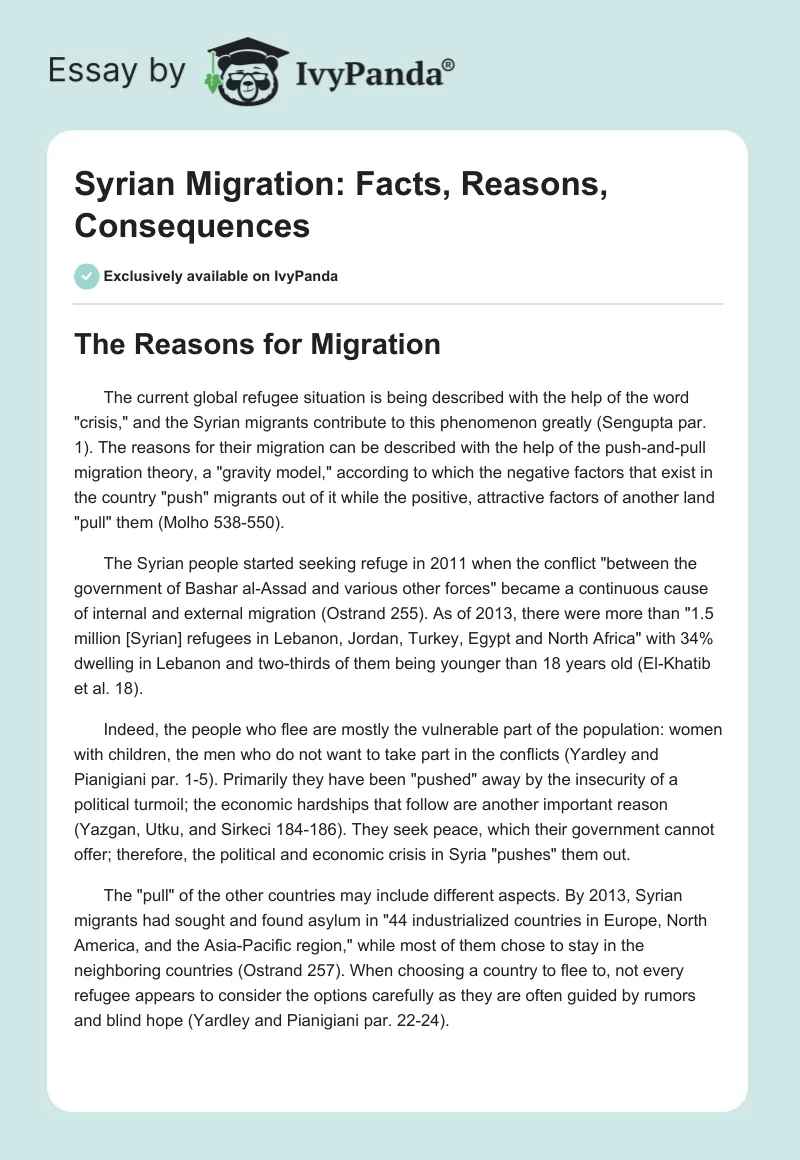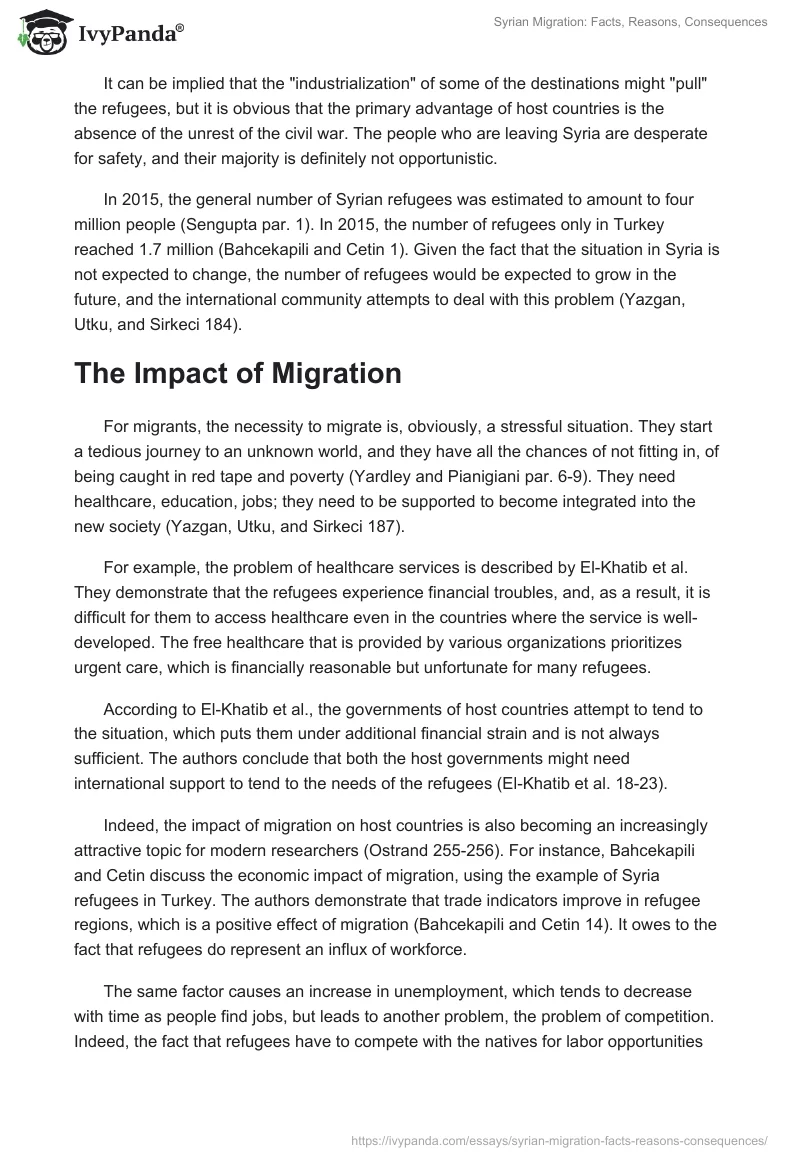The Reasons for Migration
The current global refugee situation is being described with the help of the word “crisis,” and the Syrian migrants contribute to this phenomenon greatly (Sengupta par. 1). The reasons for their migration can be described with the help of the push-and-pull migration theory, a “gravity model,” according to which the negative factors that exist in the country “push” migrants out of it while the positive, attractive factors of another land “pull” them (Molho 538-550).
The Syrian people started seeking refuge in 2011 when the conflict “between the government of Bashar al-Assad and various other forces” became a continuous cause of internal and external migration (Ostrand 255). As of 2013, there were more than “1.5 million [Syrian] refugees in Lebanon, Jordan, Turkey, Egypt and North Africa” with 34% dwelling in Lebanon and two-thirds of them being younger than 18 years old (El-Khatib et al. 18).
Indeed, the people who flee are mostly the vulnerable part of the population: women with children, the men who do not want to take part in the conflicts (Yardley and Pianigiani par. 1-5). Primarily they have been “pushed” away by the insecurity of a political turmoil; the economic hardships that follow are another important reason (Yazgan, Utku, and Sirkeci 184-186). They seek peace, which their government cannot offer; therefore, the political and economic crisis in Syria “pushes” them out.
The “pull” of the other countries may include different aspects. By 2013, Syrian migrants had sought and found asylum in “44 industrialized countries in Europe, North America, and the Asia-Pacific region,” while most of them chose to stay in the neighboring countries (Ostrand 257). When choosing a country to flee to, not every refugee appears to consider the options carefully as they are often guided by rumors and blind hope (Yardley and Pianigiani par. 22-24).
It can be implied that the “industrialization” of some of the destinations might “pull” the refugees, but it is obvious that the primary advantage of host countries is the absence of the unrest of the civil war. The people who are leaving Syria are desperate for safety, and their majority is definitely not opportunistic.
In 2015, the general number of Syrian refugees was estimated to amount to four million people (Sengupta par. 1). In 2015, the number of refugees only in Turkey reached 1.7 million (Bahcekapili and Cetin 1). Given the fact that the situation in Syria is not expected to change, the number of refugees would be expected to grow in the future, and the international community attempts to deal with this problem (Yazgan, Utku, and Sirkeci 184).
The Impact of Migration
For migrants, the necessity to migrate is, obviously, a stressful situation. They start a tedious journey to an unknown world, and they have all the chances of not fitting in, of being caught in red tape and poverty (Yardley and Pianigiani par. 6-9). They need healthcare, education, jobs; they need to be supported to become integrated into the new society (Yazgan, Utku, and Sirkeci 187).
For example, the problem of healthcare services is described by El-Khatib et al. They demonstrate that the refugees experience financial troubles, and, as a result, it is difficult for them to access healthcare even in the countries where the service is well-developed. The free healthcare that is provided by various organizations prioritizes urgent care, which is financially reasonable but unfortunate for many refugees.
According to El-Khatib et al., the governments of host countries attempt to tend to the situation, which puts them under additional financial strain and is not always sufficient. The authors conclude that both the host governments might need international support to tend to the needs of the refugees (El-Khatib et al. 18-23).
Indeed, the impact of migration on host countries is also becoming an increasingly attractive topic for modern researchers (Ostrand 255-256). For instance, Bahcekapili and Cetin discuss the economic impact of migration, using the example of Syria refugees in Turkey. The authors demonstrate that trade indicators improve in refugee regions, which is a positive effect of migration (Bahcekapili and Cetin 14). It owes to the fact that refugees do represent an influx of workforce.
The same factor causes an increase in unemployment, which tends to decrease with time as people find jobs, but leads to another problem, the problem of competition. Indeed, the fact that refugees have to compete with the natives for labor opportunities has the potential for causing conflicts and increases the rates of internal migration (Molho 551).
Finally, the sudden increase of population affects the GDP per capita index, and the authors conclude that despite the positive effects on the trade, refugees do not contribute to the growth of the economy (at least, not in Turkey). Similarly, Ostrand studies the host countries of Europe and the US, finds that the governments of the countries are committed to alleviating the hardships of the Syrian conflicts, and claims that even these well-developed countries suffer from the economic strain.
While the studies focus on particular countries, they demonstrate the general characteristics of a host country position. Refugees are a vulnerable part of the population that requires support, which is typically reflected in financial strain, especially given the numbers of Syrian refugees. For example, in 2013, Syrian refugees accounted for 7% of the population of Lebanon (El-Khatib et al. 18).
The international community acknowledges the necessity of helping the people who are forced to leave their homes, but it also recognizes the strain that is caused by the host countries, and a balance between the interests of the refugees and the natives is being sought (Ostrand 256). For example, it is reflected in the 2015 plan for the fair distribution of migrants, which sets a quota of migrants for every EU country depending on its economic development and capabilities.
This plan is supposed to alleviate the strain of weaker economies and encourage the stronger ones to assist within reasonable limits (Aisch and Almukhtar par. 1-2). So far, for example, a number of European countries (especially Sweden and Germany) have welcomed an unreasonably large number of refugees (Aisch and Almukhtar par. 6-9).
While their decision is most honorable, it is hoped that the governments of these countries assess their capacities in a reasonable way and do not neglect the interests of their nations. In the meantime, the US government intends to raise the refugee quota as well (Sengupta par. 23).
The readiness of other countries to accept the refugees could be another “pull” factor for migration. Still, it is apparent that the key reason for Syrian migration is the “push” factor, that is, the terrors of Syrian conflicts, which people would try to escape in any case. That is why the management of the refugee crisis is a necessary set of activities that are being carried out on the international level.
Works Cited
Aisch, Gregor, and Sarah Almukhtar. “Seeking a Fair Distribution of Migrants in Europe.” The New York Times, 2015. Web.
Bahcekapili, Cengiz, and Buket Cetin. “The Impacts Of Forced Migration On Regional Economies: The Case Of Syrian Refugees In Turkey.” International Business Research 8.9 (2015): 1-16. ProQuest. Web.
El-Khatib, Ziad, David Scales, Jo Vearey, and Birger Forsberg. “Syrian Refugees, Between Rocky Crisis In Syria And Hard Inaccessibility To Healthcare Services In Lebanon And Jordan.” Conflict and Health 7.1 (2013): 18-22. ProQuest. Web.
Molho, Ian. “Theories of Migration: A Review.” Scottish Journal of Political Economy 60.5 (2013): 526-556. Business Source Complete. Web.
Ostrand, Nicole. “The Syrian Refugee Crisis: A Comparison Of Responses By Germany, Sweden, The United Kingdom, And The United States.” Journal on Migration and Human Security 3.3 (2015): 255-279. ProQuest. Web.
Sengupta, Somini. “Refugee Crisis in Europe Prompts Western Engagement in Syria.” The New York Times, 2015. Web.
Yardley, Jim, and Gaia Pianigiani. “Out of Syria, Into a European Maze.” The New York Times, 2013. Web.
Yazgan, Pinar, Deniz Eroglu Utku, and Ibrahim Sirkeci. “Syrian Crisis and Migration.” Migration Letters 12.3 (2015): 181-192. ProQuest. Web.


